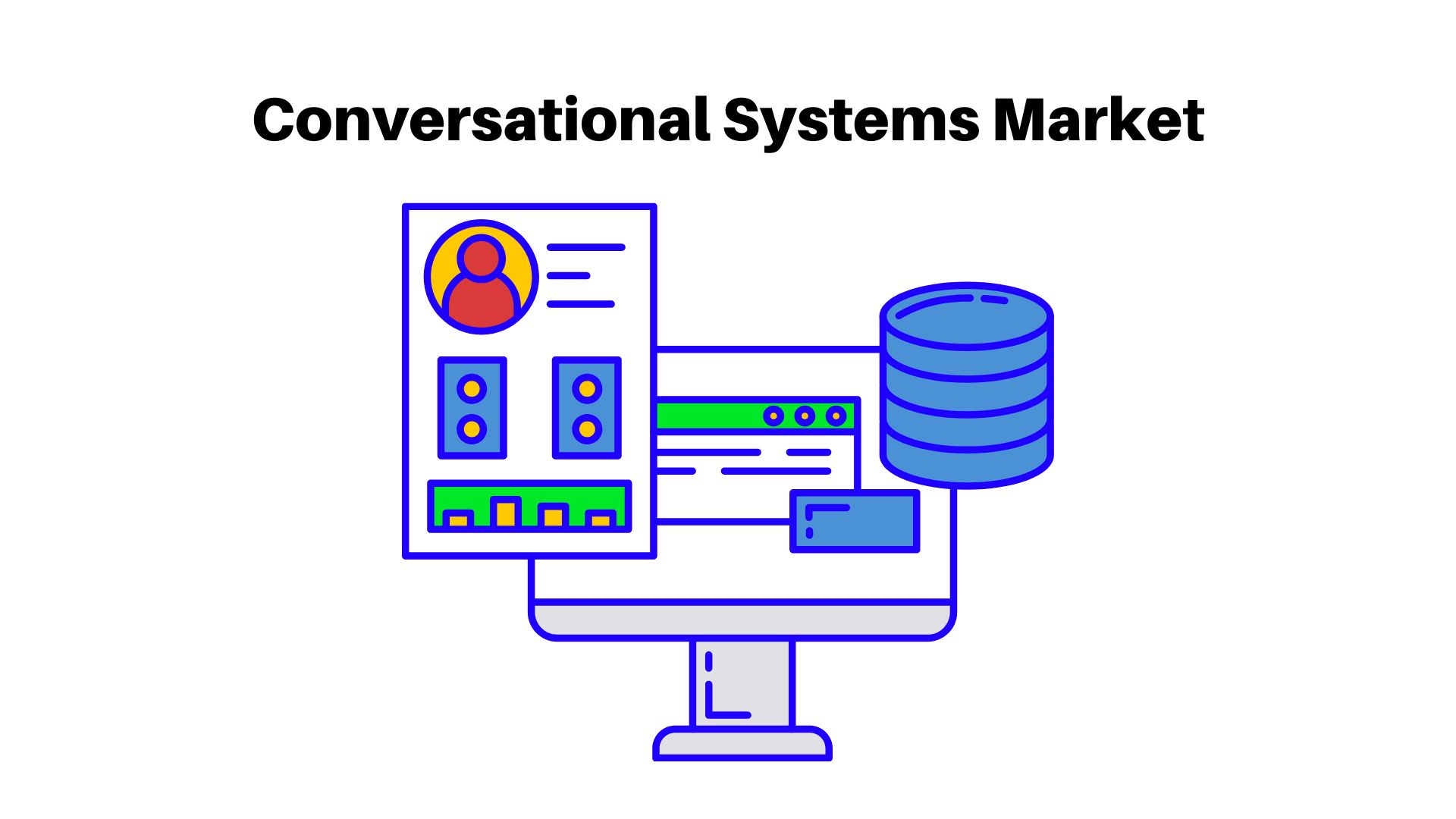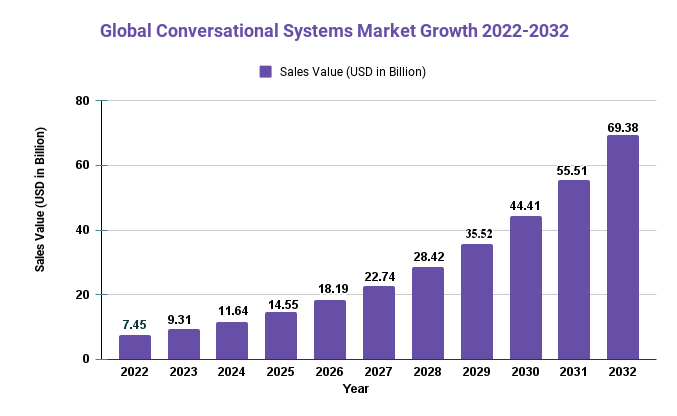Conversational Systems Market News and Growth 25% (Status and Outlook), 2022-2032

Page Contents
Market Overview
The Conversational systems market refers to technologies and solutions that enable human-like interactions between machines and humans. These systems use natural language processing (NLP), machine learning, and artificial intelligence (AI) in order to comprehend and respond to human inputs in a conversational fashion. As demand for automated customer service, personalized shopping experiences, and virtual assistants grows across various industries, the market for conversational systems will continue growing at an impressive rate.
The conversational systems market was growing rapidly and was predicted to remain so in the coming years. Conversational systems, otherwise known as chatbots, are software programs that mimic human communication through voice or text interactions. They can be utilized for many purposes such as customer service, sales, and marketing.
According to Market.us' report, the global conversational systems market was valued at USD 7.45 billion in 2022 and is projected to reach USD 69.38 billion by 2032, expanding at a compound annual growth rate (CAGR) of 25% during that timeframe. The growth is attributed to rising demand for AI-powered chatbots, rising adoption by small and medium-sized enterprises (SMEs), as well as needs to enhance customer engagement and experience.
Report findings identified North America as the leading market for conversational systems, followed by Europe and Asia Pacific. Beyond customer service and support applications, chatbots are being adopted across healthcare, education, and financial services industries alike. With the integration of natural language processing and machine learning technologies, chatbots will continue to improve their capabilities and enable more advanced use cases.
Overall, the conversational systems market is expected to experience significant growth over the coming years due to rising demand for AI-powered chatbots and businesses' desire to enhance customer engagement and experience.

Would you like to access the statistical information, graphs, and key players' tactics? click here
Key Takeaways
- In 2022, the global conversational systems market was valued at USD 7.45 billion; it is projected to reach USD 69.38 billion by 2032 at a compound annual growth rate (CAGR) of 25% over this forecast period.
- Conversational systems are becoming more and more popular due to the growing need for personalized customer experiences and the rising adoption of artificial intelligence and machine learning technologies.
- Conversational systems are becoming increasingly popular across a range of industries, such as healthcare, retail, BFSI, and automotive.
- North America is the leading market for conversational systems, followed by Europe and Asia-Pacific. The latter region is expected to experience the fastest growth over the forecast period due to increasing investments in AI and machine learning technologies by companies there.
Regional Snapshot
North America is the leading market for conversational systems, driven by large technology companies and the early adoption of advanced technologies. The US accounts for most of this share in North America. The European market for conversational systems is highly developed, with major
contributors coming from countries such as the UK, Germany, and France. The Asia-Pacific region is expected to experience the fastest growth during the forecast period, due to increased investments in AI and machine learning technologies by companies there. Furthermore, the rising demand for conversational systems in emerging economies such as China and India should contribute significantly to this region's expansion.
Drivers
The demand for conversational systems is being driven by several factors
As customer experience demands evolve, personalized customer experiences become even more essential. Artificial intelligence and machine learning technologies have seen a meteoric rise, creating demand for automated customer service solutions. Virtual assistants have seen unprecedented popularity as virtual assistants vie with chatbots to provide answers across various industries.
Need for cost-effective and efficient customer support solutions
Restraints
The growth of the conversational systems market is being limited by several factors
- Technical difficulties and risks related to natural language processing and machine learning
- Privacy and security threats related to data sharing and storage
- High initial costs of implementation and integration with existing systems
- Technical constraints in accessing needed features in existing systems.
- Unconscious lack of awareness and comprehension regarding conversational systems among businesses and end-users
In conclusion, the conversational systems market is expected to experience tremendous growth in the coming years due to rising customer preferences for personalized experiences, rising adoption of artificial intelligence and machine learning technologies, as well as need for cost-effective yet efficient customer support solutions. While there are certain challenges such as technical complexities and privacy concerns, opportunities exist – particularly within Asia-Pacific regions.
Opportunities
- Increased Customer Engagement: Conversational systems can enhance customer engagement through personalized experiences and real-time interactions, leading to increased satisfaction and loyalty among your customers.
- Cost Savings: Conversational systems can assist organizations in cutting down on customer support expenses, as they are capable of handling a high volume of inquiries and offering 24/7 assistance.
- Improved Efficiency: Conversational systems can automate routine tasks, freeing employees to focus on more complex assignments and increasing overall efficiency.
- Market Expansion: Conversational systems can enable organizations to expand their reach by offering multilingual support and enabling them to interact with customers across different regions.
Challenges
- Technical Complexity: Conversational systems require advanced natural language processing (NLP) and machine learning (ML) capabilities, which can be challenging to implement and maintain.
- Data Privacy Concerns: Conversational systems store and process large amounts of personal data, prompting concerns around data privacy and security.
- Integration with Legacy Systems: Integrating conversational systems with legacy applications can be a complex and time-consuming endeavor, particularly for organizations with complex IT architectures.
- Lack of Human Touch: Conversational systems can offer efficient and cost-effective customer support, but some customers may prefer human interactions for certain issues.
View Detailed TOC of the Report: https://market.us/report/conversational-systems-market/table-of-content/
Recent Developments
- Multimodal Conversational Systems: These systems integrate voice, text, and visual interfaces for more personalized and engaging experiences.
- Conversational AI Platforms: These services offer pre-built conversational components and tools to make developing and deploying conversational systems much simpler.
- Natural language understanding (NLU) advancements: Recent improvements in NLU technology have significantly enhanced conversational systems' capacity to comprehend and respond to complex inquiries and requests.
- Expansion of Conversational Systems Beyond Customer Support: Conversational systems are being employed in fields such as healthcare, finance, and education to offer personalized and interactive experiences.
Key Market Segments
Component
- Compute Platforms
- Solutions
- Services
Type
- Text Assistant
- Voice Assisted
- Other Types
Application
- Branding & Advertisement
- Customer Support & Personal Assistant
- Data Privacy & Compliance
- Other applications
End-use
- BFSI
- Healthcare & Life Sciences
- Media & Entertainment
- Retail & E-commerce
- Telecommunication
- Travel & Hospitality
- Other End-Uses
Key Market Players
- Amazon Web Services, Inc.
- Artificial Solutions
- Baidu, Inc.
- Conversica, Inc.
- Google LLC
- IBM Corporation
- Microsoft Corporation
- Nuance Communications, Inc.
- Other Key Players
Report Scope
| Report Attribute | Details |
| The market size value in 2022 | USD 7.45 Bn |
| Revenue Forecast by 2032 | USD 69.38 Bn |
| Growth Rate | CAGR Of 25% |
| Regions Covered | North America, Europe, Asia Pacific, Latin America, and Middle East & Africa, and Rest of the World |
| Historical Years | 2017-2022 |
| Base Year | 2022 |
| Estimated Year | 2023 |
| Short-Term Projection Year | 2028 |
| Long-Term Projected Year | 2032 |
Frequently Asked Questions
Q: What are the most frequent use cases for conversational systems?
A: Common use cases include customer support, sales & marketing, as well as personal assistants.
Q: What's the difference between a chatbot and a virtual assistant?
A: A chatbot is a software program that uses predefined rules or machine learning algorithms to simulate human conversation, while a virtual assistant is more of an advanced system capable of performing tasks and providing recommendations based on user preferences.
Q: Can conversational systems be used in languages other than English?
Absolutely, conversational systems can be utilized across a range of languages with pre-built tools and models varying depending on the dialect.
Q: How do conversational systems handle sensitive data?
A: Conversational systems must adhere to data privacy regulations and implement security measures such as encryption and access controls in order to safeguard sensitive information.
Q: How do organizations assess the success of conversational systems?
A: Organizations typically gauge success by tracking metrics such as customer satisfaction, response times, and conversion rates.
The team behind market.us, marketresearch.biz, market.biz and more. Our purpose is to keep our customers ahead of the game with regard to the markets. They may fluctuate up or down, but we will help you to stay ahead of the curve in these market fluctuations. Our consistent growth and ability to deliver in-depth analyses and market insight has engaged genuine market players. They have faith in us to offer the data and information they require to make balanced and decisive marketing decisions.